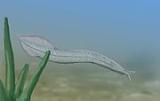
Pikaia
Overview
Cambrian
The Cambrian is the first geological period of the Paleozoic Era, lasting from Mya ; it is succeeded by the Ordovician. Its subdivisions, and indeed its base, are somewhat in flux. The period was established by Adam Sedgwick, who named it after Cambria, the Latin name for Wales, where Britain's...
Burgess Shale
Burgess Shale
The Burgess Shale Formation, located in the Canadian Rockies of British Columbia, is one of the world's most celebrated fossil fields, and the best of its kind. It is famous for the exceptional preservation of the soft parts of its fossils...
of British Columbia
British Columbia
British Columbia is the westernmost of Canada's provinces and is known for its natural beauty, as reflected in its Latin motto, Splendor sine occasu . Its name was chosen by Queen Victoria in 1858...
.
It was discovered by Charles Walcott and was first described by him in 1911. It was named after Pika Peak
Pika Peak
Pika Peak is a mountain located between Mount Richardson and Ptarmigan Peak in Banff National Park. The mountain was named in 1928 after the pika, the small "rock rabbit" that inhabits alpine regions....
, a mountain in Alberta
Alberta
Alberta is a province of Canada. It had an estimated population of 3.7 million in 2010 making it the most populous of Canada's three prairie provinces...
, Canada
Canada
Canada is a North American country consisting of ten provinces and three territories. Located in the northern part of the continent, it extends from the Atlantic Ocean in the east to the Pacific Ocean in the west, and northward into the Arctic Ocean...
. Based on the obvious and regular segmentation of the body, Walcott classified it as a polychaete worm. It resembles a living chordate
Chordate
Chordates are animals which are either vertebrates or one of several closely related invertebrates. They are united by having, for at least some period of their life cycle, a notochord, a hollow dorsal nerve cord, pharyngeal slits, an endostyle, and a post-anal tail...
commonly known as the lancelet
Lancelet
The lancelets , also known as amphioxus, are the modern representatives of the subphylum Cephalochordata, formerly thought to be the sister group of the craniates. They are usually found buried in sand in shallow parts of temperate or tropical seas. In Asia, they are harvested commercially as food...
and perhaps swam much like an eel
Eel
Eels are an order of fish, which consists of four suborders, 20 families, 111 genera and approximately 800 species. Most eels are predators...
.
During his re-examination of the Burgess Shale fauna in 1979, paleontologist
Paleontology
Paleontology "old, ancient", ὄν, ὀντ- "being, creature", and λόγος "speech, thought") is the study of prehistoric life. It includes the study of fossils to determine organisms' evolution and interactions with each other and their environments...
Simon Conway Morris
Simon Conway Morris
Simon Conway Morris FRS is an English paleontologist made known by his detailed and careful study of the Burgess Shale fossils, an exploit celebrated in Wonderful Life by Stephen Jay Gould...
placed P.
Discussions

